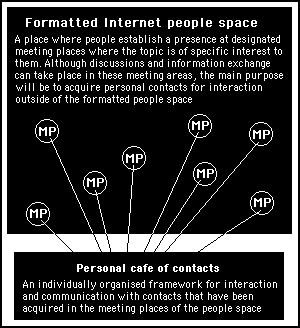
Chapter 11
The enigmatic world of bots and personal agents
Focus of attention
Another interesting view point came out of a correspondence I had with Richard Ross, a Brit working in San Francisco. I'd met Richard some three years previously when I'd given a talk at the Hub Club in London about using agents that could represent people on the Web. When Richard heard that I would be visiting San Francisco to present a paper at BOT2001 (the annual event for all people interested in bots and intelligent agents) he suggested we met up for a chat.
To explain what I'd be talking about at BOT2001, I sent him a copy of the paper, which included a description of a living database as described in the previous two chapter. He wrote back:
I have just read the paper. What I like about it is that is suggests an approach for that old problem so rarely recognized in DP of dealing with qualitative as opposed to quantitative information and recognizes the expertise of the individual perspective in this domain.
I must say though, I'd rather see a description of the data domain less hierarchically structured. Instead of describing the data field as a tree with fixed hierarchies as implied by the address system you describe for "navigating" it (this sounds suspiciously hypertextual), I'd rather see a metaphor of the address description being a non-hierarchical one that configures the data field around me, i.e. it just offers me a particular perspective.
I could plug in things like location, language, volume etc. and I would find myself at the same cafe table as before but with having imposed rather less assumptions about the nature of the information in this domain. I suppose it's more like data visualization than navigation. It's ultimately about how I can reconfigure the way I might see the world so that it allows me to do some useful work.
Interesting stuff though, and yes, I have always thought the real power of the web was people.
Richard Ross
What I had failed to do was to provide Richard with any of the details of the personal virtual cafe. He could only visualise one half of the story: the moving around in the space, to meeting places where he could make contact with people. This view sees all the person to person interaction as happening only at meeting places on the server side of the Web.
The full story however sees the meetings as happening not only in a shared space but in a personal and private space: within the confines of a cafe created in the memory of every users own computer. These meetings will then be under individual control, where additional contacts can be brought in from anywhere in the formatted space.
This effectively reconfigures the people space individually, for every person using it, making them the centre of a non hierarchical information network that allows them to include only the people and contacts relevant to their interests.
In other words, a people space isn't set up to be the sole infra structure for interpersonal communication and interaction: it's main purpose is to allow people to find appropriate others who they can then bring into their own private information network. This is organised through their personal virtual cafe where the interactions are outside of and apart from the formal structure of the people space (see figure 11.1).

Figure 11.1
Showing diagrammatically how a formatted people space is used primarily as a source of acquiring personal contacts for a private communication network
With this visualisation of the concept, the user of a people space is not restricted at all by its formatting. The formatting has only the same significance in a people space as lines of latitude and longitude have on a map of the world: they provide a grid reference.
This can be appreciated once you realise that the route to any meeting place need not be through the hierarchies of categories. A meeting place may be recommended by somebody. This recommendation would simply provide a reference of the form "BHEAC", which would allow anyone to navigate straight to a meeting place without even being aware of the hierarchical nature of the formatting.